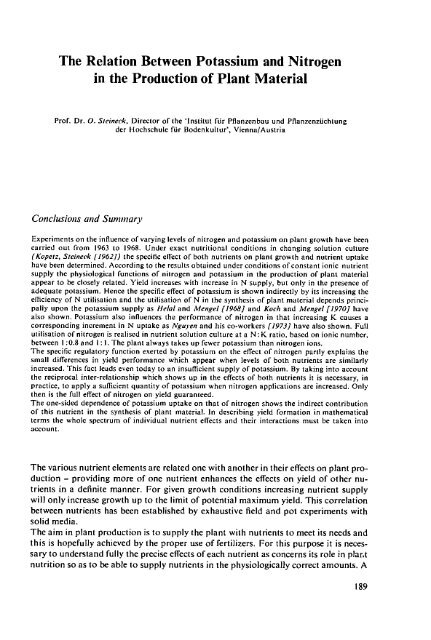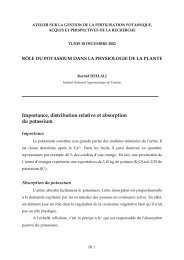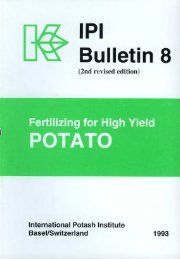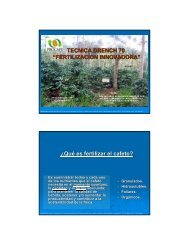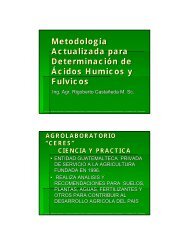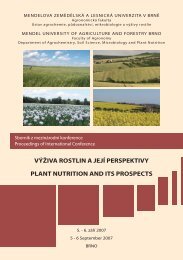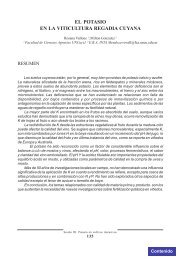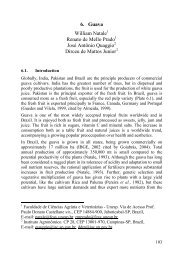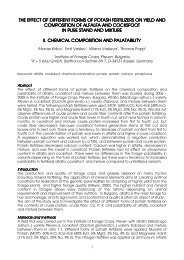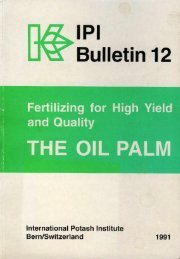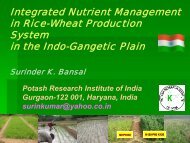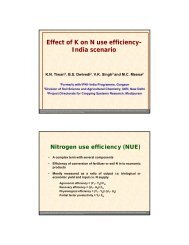Potassium Research and Agricultural Production - The International ...
Potassium Research and Agricultural Production - The International ...
Potassium Research and Agricultural Production - The International ...
Create successful ePaper yourself
Turn your PDF publications into a flip-book with our unique Google optimized e-Paper software.
<strong>The</strong> Relation Between <strong>Potassium</strong> <strong>and</strong> Nitrogen<br />
in the <strong>Production</strong> of Plant Material<br />
Prof. Or. O. Sll!ineck, Director of the 'Institut fUr Pflanzenbau und Pflanzenziichtung<br />
der Hochschule fUr Bodenkultur', Vienna/Austria<br />
Conclusions <strong>and</strong> Summary<br />
Experiments on the influence of varying levels of nitrogen <strong>and</strong> potassium on plant growth have been<br />
carried out from 1963 to 1968. Under exact nutritional conditions in changing solution culture<br />
(Kopetz, 5tdneck [1962]) the specific effect of both nutrients on plant growth <strong>and</strong> nutrient uptake<br />
have been determined. According to the results obtained under conditions of constant ionic nutrient<br />
supply the physiological functions of nitrogen <strong>and</strong> potassium in the production of plant material<br />
appear to be closely related. Yield increases with increase in N supply, but only in the presence of<br />
adequate potassium. Hence the specific effect of potassium is shown indirectly by its increasing the<br />
efficiency of N utilisation <strong>and</strong> the utilisation of N in the synthesis of plant material depends principally<br />
upon the potassium supply as He/aJ <strong>and</strong> MengeJ [J968} <strong>and</strong> Koch <strong>and</strong> MengeJ [1970J have<br />
also shown. <strong>Potassium</strong> also innuences the performance of nitrogen in that increasing K causes a<br />
corresponding increment in N uptake as Nguyen <strong>and</strong> his co-workers [1973} have also shown. Full<br />
utilisation of nitrogen is realised in nutrient solution culture at aN: K ratio, based on ionic number,<br />
between I :0.8 <strong>and</strong> I: 1. <strong>The</strong> plant always takes up fewer potassium than nitrogen ions.<br />
<strong>The</strong> specific regulatory function exerted by potassium on the effect of nitrogen partly explains the<br />
small differences in yield performance which appear when levels of both nutrients are similarly<br />
increased. This fact leads even today to an insufficient supply of potassium. By taking into account<br />
the reciprocal inter-relationship which shows up in the effects of both nutrients it is necessary, in<br />
practice, to apply a sufficient quantity of potassium when nitrogen applications arc increased. Only<br />
then is the full effect of nitrogen on yield guaranteed.<br />
<strong>The</strong> one-sided dependence of potassium uptake on that of nitrogen shows the indirect contribution<br />
of this nutrient in the synthesis of plant material. In describing yield formation in mathematical<br />
terms the wholc spectrum of individual nutrient effects <strong>and</strong> their interactions must be taken into<br />
account.<br />
<strong>The</strong> various nutrient elements are related one with another in their effects on plant production<br />
- providing more of one nutrient enhances the effects on yield of other nutrients<br />
in a definite manner. For given growth conditions increasing nutrient supply<br />
will only increase growth up to the limit of potential maximum yield. This correlation<br />
between nutrients has been established by exhaustive field <strong>and</strong> pot experiments with<br />
solid media.<br />
<strong>The</strong> aim in plant production is to supply the plant with nutrients to meet its needs <strong>and</strong><br />
this is hopefully achieved by the proper use of fertilizers. For this purpose it is necessary<br />
to underst<strong>and</strong> fully the precise effects of each nutrient as concerns its role in plar.t<br />
nutrition so as to be able to supply nutrients in the physiologically correct amounts. A<br />
189


